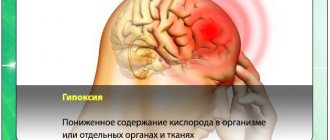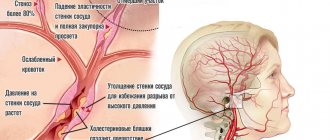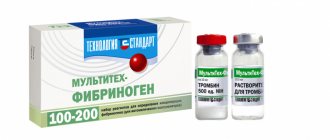Basic electrolytes
Potassium
- an important component of most cells. Together with other electrolytes, potassium ions are responsible for the functioning of muscles and nerves, normal acid-base balance, and water metabolism. The blood contains only a small amount of the macronutrient; even minor fluctuations in its level lead to serious consequences. Significant deviations from the norm can lead to life-threatening conditions (shock, cardiac dysfunction, respiratory failure, etc.). Normal potassium concentration is 3.5-5.1 mmol/liter.
Magnesium
participates in energy production, enzyme synthesis, muscle contraction and other vital processes. It is absorbed from food into the gastrointestinal tract and excreted by the kidneys. A deficiency of this electrolyte can be caused by poor nutrition, problems with its absorption, or excessive loss in urine. Elevated levels may indicate kidney pathologies. Significant electrolyte deficiency leads to symptoms such as weakness, confusion, loss of appetite, and muscle spasms. Its excess manifests itself in a similar way. Heart rhythm disturbances and nausea may also be added to the symptoms.
Sodium
present in all tissues and fluids of the body. It is necessary for muscle contraction and maintaining water-salt balance. The macroelement is absorbed in the intestines from ordinary table salt. Deviations of its normal level are associated with a violation of one of the mechanisms of its maintenance. For example, normal sodium concentrations are disrupted if antidiuretic hormone, which prevents fluid loss through urine, is produced in abnormal amounts. A violation of the amount of this electrolyte leads to the appearance of edema or dehydration, as the amount of fluid in the tissues changes. Sodium testing is used in the diagnosis of many diseases (for example, pathologies of the kidneys, lungs, brain).
Chlorine
It is part of many biologically active substances and performs a number of physiological functions. Its level is normally relatively stable (a slight decrease in levels is observed after eating). A test for the amount of chlorine is often prescribed in conjunction with other studies to identify various pathologies. Its results are also used to determine the cause of weakness, prolonged vomiting, diarrhea, and breathing problems.
Normal blood chlorine content
The indicator of the substance changes according to the age of the person. There is no division depending on gender, since hormonal levels or physiological characteristics do not affect the volume of chlorine. When interpreting the results of a blood test for chlorine, a table is used that shows the upper and lower limits of normal. A result higher or lower than them is a reason for a full examination.
- From birth to 2 months - 97-117 mmol/l.
- From 2 months to 12 months - 94-114 mmol/l.
- From 12 months to 15 years - 95-109 mmol/l.
- From 15 years - 96-106 mmol/l.
To determine the level of a substance in the body, not only blood, but also urine is often examined. This allows you to obtain maximum data about a person’s condition.
Foods rich in chlorine
Since chlorine enters the body from the outside, in order not to increase its level to dangerous values, you should not consume foods rich in it in large quantities. These include:
- buckwheat grain,
- rice cereal,
- peas,
- eggs,
- fatty sea fish,
- crucian carp
Also, speaking about how to lower the level of chlorides in the blood through nutrition, it should be noted that table and sea salts retain fluid in the body and prevent the timely release of chlorine, which is why its normal concentration in the body is exceeded. It is especially necessary to monitor nutrition for persons with predisposing factors for high levels of this substance in the blood.
How is the analysis carried out?
In order to determine increased or decreased chlorine in the blood, it is taken from a vein on the elbow or the inside of the wrist. The choice is up to the nurse performing the test and depends on the availability of the vein. Blood is taken using a special syringe or thin needle and test tube after antiseptic treatment of the skin in the puncture area. The entire procedure for collecting material takes 2-3 minutes. The collection is carried out on an empty stomach from 8 a.m. to 12 noon.
The resulting blood is centrifuged to separate the plasma. This is necessary in order to obtain blood serum. Chlorine is isolated in the serum using special compounds. Then the amount of chlorides is determined. Based on the results of the analysis, additional examination or treatment may be prescribed if the cause of the pathological disorder in the blood is known.
- Blood cholesterol levels - table by age. Cholesterol in the blood - norms for women, men and children
What causes chlorine levels to rise?
When blood chlorine is elevated, there may be various reasons for this. All of them are divided into 2 large categories - relative and absolute. Relative causes of increased chlorine include:
- dehydration,
- increased blood viscosity,
- unhealthy diet
- increased thrombus formation.
Fluid deficiency in the body is considered the primary cause of increased chlorides in the blood. Dehydration can develop both due to insufficient water intake and due to the use of diuretics, dysbacteriosis, prolonged intense diarrhea and profuse vomiting. If there is insufficient fluid, the body loses the ability to remove excess substances through sweat or urine and therefore its level, if necessary, cannot be lowered naturally.
It is known that more chlorine is lost with intense and repeated vomiting than with diarrhea. This is how hypochloremia develops.
The absolute reasons that the level of chlorine in the blood is elevated are:
- nephritis,
- nephrosis,
- nephrosclerosis,
- disturbance of metabolic processes,
- metabolic acidosis,
- excessively strong and very frequent breathing,
- disorders in the functioning of the cardiovascular system,
- renal failure,
- Cushing's disease,
- diabetes insipidus,
- acetylsalicylic acid poisoning,
- urethrosigmostomy,
- use of carbanhydrase inhibitors (Diacarb).
The group is called absolute, since in all of the above diseases and conditions, chlorides in the blood are always elevated.
Diagnostics
As mentioned above, the diagnosis of hyperchloremia almost always requires additional examination. The doctor must understand why this phenomenon occurred. This is necessary to prescribe competent treatment.
What procedures will help determine that chlorine is elevated? Blood analysis. He will also determine whether a person has problems associated with the liver or kidneys.
The patient will also need to provide the doctor with information regarding his diet and list the medications he is taking, even dietary supplements and herbal supplements. Often, it is because of the medications used that the chlorine level changes.
Low chlorine levels: causes, symptoms and signs
Pressure surges are not a specific sign of hypochloremia
A person sometimes experiences low levels of chlorine. This condition may also indicate dangerous pathologies. Most often, the cause of this phenomenon is pathologies of the gastrointestinal tract of an inflammatory nature. The complete exact picture of chlorine deficiency in the human body has not yet been determined, but the most characteristic manifestations of the condition are:
- severe exhaustion leading to anorexia;
- insufficient urge to defecate;
- hair loss;
- loss of teeth (in especially severe cases);
- swelling;
- constant pronounced surges in blood pressure;
- alkalosis.
If at least some of the symptoms of the disorder appear, it is necessary to undergo an examination, including identifying the level of chlorine in the blood.
What analysis reveals the level of chlorides, can the results be erroneous?
Chlorides in the blood are increased, decreased, or their concentration is normal - determined by analyzing peripheral blood taken from a vein at the elbow in a volume of 5-8 ml. An ion-selective research method is used. The chlorine level is determined taking into account the potential difference between the indicator electrode and the reference electrode placed in the blood sample.
A referral can be issued for the following types of research:
- Blood chemistry.
- Chlorine in serum.
- Potassium, sodium, chlorine in serum.
During biochemical analysis, many indicators can be examined. The doctor selects from the list those that will help evaluate the functioning of any organ or system of the body. Chlorine and other electrolytes are noted in the direction of diseases of the kidneys and adrenal glands, heart and blood vessels.
A test for chlorine in blood serum is prescribed to monitor diseases accompanied by acid-base imbalance: diabetes insipidus, adrenal pathology. The study may be needed during the treatment of arterial hypertension, heart failure, liver and kidney diseases. The indicator is important if alkalosis or acidosis is suspected.
Tests for chlorine are carried out in patients with the threat of a serious disturbance of water and electrolyte balance:
- during hemodialysis;
- with extensive burns;
- with vomiting and diarrhea;
- with long-term therapy with diuretics.
Most chlorine is found in the blood in the form of sodium chloride.
Therefore, its concentration is closely related to the amount of sodium ions. An analysis of potassium, sodium and chlorine electrolytes is prescribed for edema, weakness, and cardiac arrhythmia. The results of chlorine analysis are not always sufficiently informative. Due to the nature of the analysis methodology, errors in the results are possible under certain conditions. Thus, with an increase in total blood protein, cholesterol and triglycerides, a lower level of chlorine is recorded than it actually is.
To avoid incorrect interpretation, tests are carried out for sodium and bicarbonates, which clarify the amount of chlorine. The following dependencies exist: with increasing sodium, the chlorine content increases; the concentration of bicarbonates decreases.
To clarify the causes of changes in water-electrolyte balance and confirm the diagnosis of renal tubular acidosis, they do not limit themselves to a blood test and measure the amount of chlorine in daily urine.
Hypernatremia
This, as the name suggests, is the name of a condition in which there is a lot of sodium in the blood. It also occurs frequently.
If sodium is elevated in the blood, and chlorine is also outside the normal range. This element is also responsible for retaining water in the body and maintaining electrolyte balance. It is also involved in the functioning of the muscular and nervous systems.
The normal level of this substance is 135–150 mmol/l in an adult. About 85% of it is found in the blood and lymph.
Consequences
If sodium and chlorine are increased in the blood, then the cells lose water, as a result of which their volume decreases. This is fraught with intracerebral hemorrhages. Diarrhea develops, intense sweating begins, and the amount of fluid in the bloodstream increases.
If the amount of cations (sodium in particular) increases to 180 mmol/l, coma, even death, is possible.
If we talk about less terrible consequences, then we should highlight disruption of the renal nephrons and the secretion of vasopressin, high blood pressure, edema (including cerebral edema) and strokes.
That is why you should not ignore symptoms, even those that seem insignificant. The sooner the problem is identified and treatment prescribed, the better.
Treatment of hyperchloremia
It is nonspecific, and therefore does not pose any special difficulties. Here's what therapy includes:
- Taking medications to prevent diarrhea, vomiting and nausea.
- Change of medications. This is the case if they are the cause of the imbalance.
- Be sure to drink 3 liters of clean water per day.
- If necessary, obtain intravenous fluids.
- Maintaining a balanced diet.
- Treatment of mental illnesses if they are the cause of digestive disorders.
- Avoid aspirin, coffee and alcohol.
- Monitoring glucose levels.
Normalizing the amount of chlorine in the blood is not difficult. But preventing hyperchloremia is not easy. Especially if it was caused by Addison's disease.
Physical and chemical properties
Content:
- Physical and chemical properties
- Biological role
- Daily norm
- Insufficiency and excess of chlorine in the body
- Sources of chlorine
- Conclusion
Chlorine is a chemical element of the main subgroup of group VII of the periodic system of D.I. Mendeleev, with atomic number 17. The compound was first isolated in its pure form in 1774 by the German chemist Carl Wilhelm Scheele in Sweden. This element is a chemically active non-metal that is part of the halogen group. Elemental chlorine under normal conditions (0 degrees) is a poisonous gas of yellow-green color with a sharp “suffocating” odor, which is 3 times “heavier” than air.
The compound reacts with almost all chemical elements, forming chlorides (except nitrogen, oxygen, carbon, inert gases). When dissolved in alkalis or water, it dismutates, turning into hypochlorous and hydrochloric acids.
In nature, chlorine is found only in mineral compounds: sylvite KCl, halite NaCl, sylvinite KCl NaCl, carnallite KCl MgCl2 6H2O, bischofite MgCl2 6H2O, kainite KCl MgSO4 3H2O. At the same time, its main reserves are concentrated in salts of sea and ocean waters, the content of which starts from 19 grams per liter.
In a healthy adult body weighing 80 kilograms, there is at least 95 grams of chlorine.











